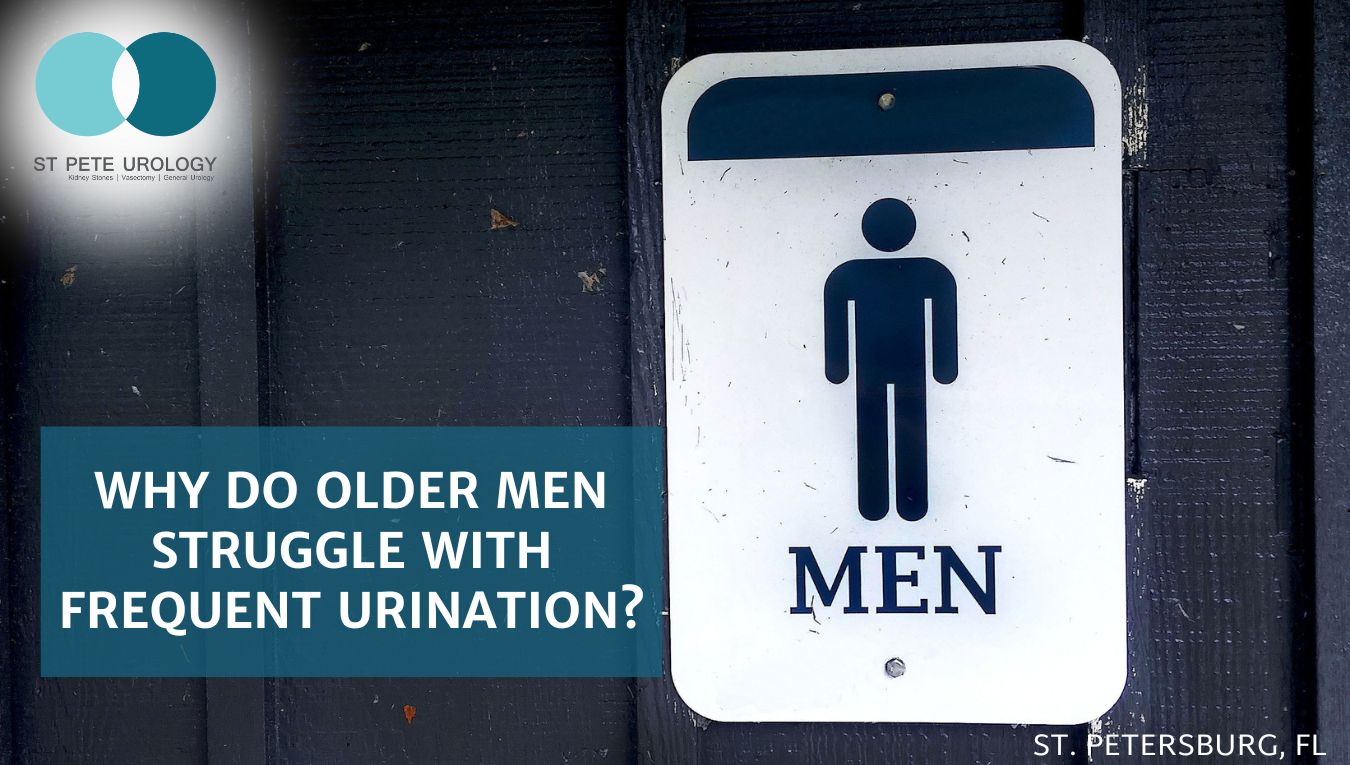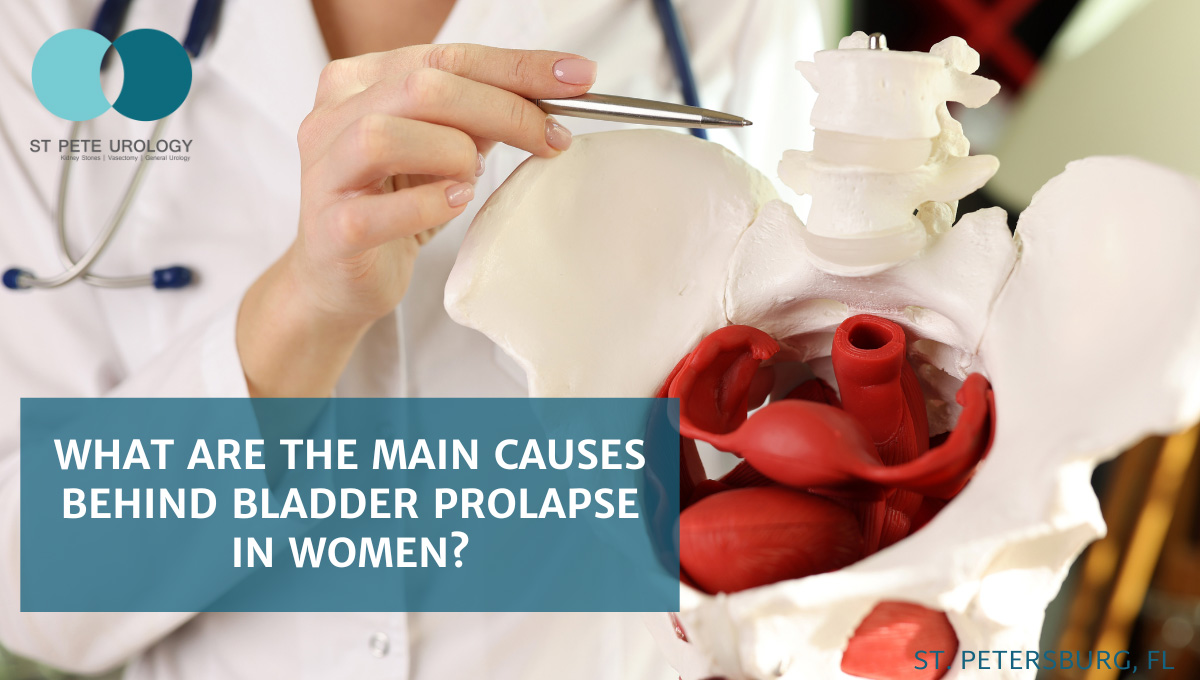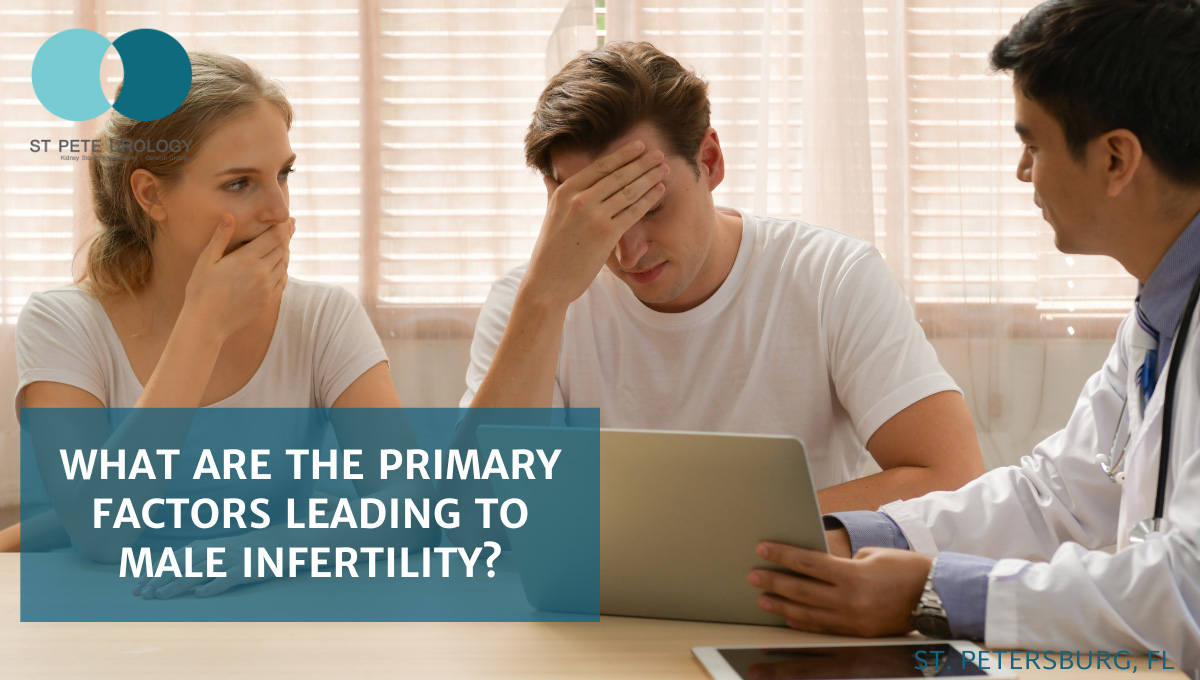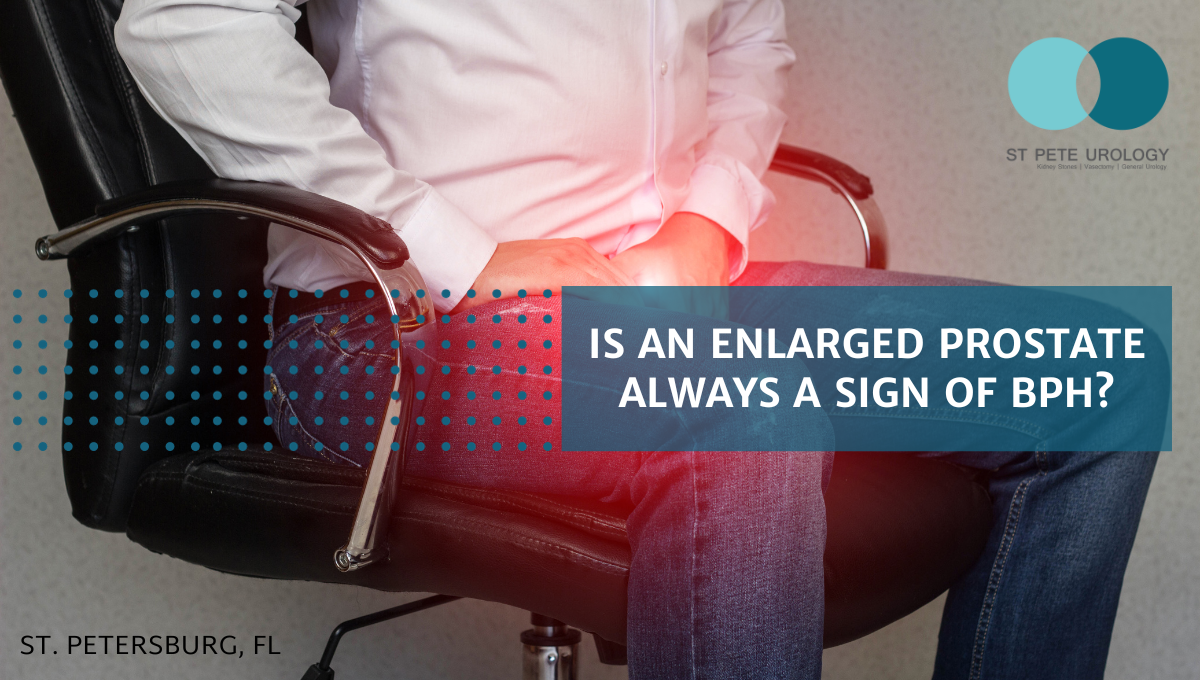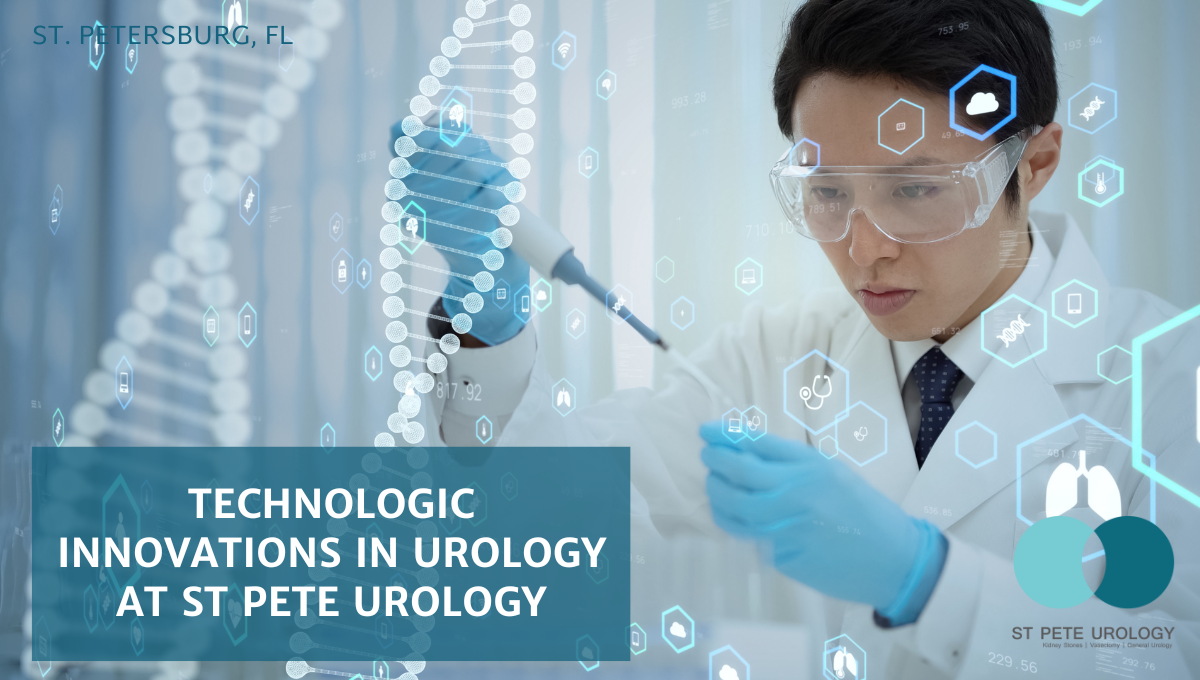Discover why frequent urination in older men occurs, its impact on daily life, and effective treatment options to improve quality of life.
Continue readingWhat Are the Main Causes Behind Bladder Prolapse in Women?
Bladder prolapse, also known as cystocele, is a health condition that could impact a woman’s quality of life significantly.
Continue readingWhat Are the Primary Factors Leading to Male Infertility?
Understanding the primary factors leading to male infertility is critical to helping you tackle the condition head-on.
Continue readingWhat Causes Incontinence
Dr. Nicholas Laryngakis discusses the factors on what causes incontinence and the complications and risks associated with the condition.
Continue readingHow Prevalent Is Erectile Dysfunction and What Are Its Primary Causes?
Key Takeaways:
- Erectile dysfunction is a very common condition affecting around 52% of men globally.
- ED is usually caused by a combination of physical, psychological, and lifestyle factors.
- Professional help from trained medical experts is necessary to diagnose, treat, and manage ED.

In the realm of men’s health, few conditions can be as disconcerting and confounding as erectile dysfunction (ED). Characterized by the chronic inability to achieve and maintain an erection sufficient for sexual activity, erectile dysfunction denotes a significant compromise in a man’s intimate life. It’s essential to understand not only the prevalence of this condition but also its underlying causes to demystify the condition, foster greater awareness, and promote preventative and curative efforts.
Prevalence Of ED: A Closer Look At The Numbers
Primary Causes of ED: The Physical, Psychological, and Lifestyle Factors
More often than not, erectile dysfunction is a composite phenomenon birthed by a blend of physical, psychological, and lifestyle factors. Physical health conditions such as cardiovascular disease, diabetes, hormonal imbalances, and neurological disorders, are often the primary architects of ED. The arteries’ clogging due to heart disease, for instance, can impede blood flow, a crucial element for an erection.
Psychological factors are equally pivotal in instigating ED. The tribulations of anxiety and stress, the gloom of depression, and relationship issues can all transpire into sexual dysfunction. Erectile function is, to a significant extent, a barometer of a man’s mental state.
Lifestyle choices and habits can also conspire to catalyze ED. Smoking narrows and hardens arteries, hampering blood flow. Excessive consumption of alcohol can numb the nervous system, impairing the brain’s capacity to sense sexual stimulation. Sedentary lifestyle, poor diet, and obesity, each have their deleterious impacts on sexual health.
Risk Factors for ED: Beyond the Obvious
Age, although a significant risk factor, isn’t the sole determinant of ED. Other underlying health conditions and psychological factors can predispose individuals to this condition. As a rule of thumb, anything adverse for your heart is likely detrimental to your sexual health.
Closure: Unmasking ED to Seek Solutions
To sum up, erectile dysfunction is a prevalent condition hounded by an intricate blend of physical, psychological, and lifestyle causes. However, understanding the prevalence and primary causes enables individuals to seek professional help for diagnosis and management.
The urologists in FL at St Pete Urology are trained to address this issue comprehensively. They adopt a personalized approach to diagnose, treat, and manage ED, offering a glimmer of hope for millions of those affected. Additionally, they emphasize lifestyle modifications as effective strategies for prevention.
From mitigating risk factors to exploring treatment options, tackling ED is a journey best embarked upon with professional guidance, openness, and optimism. Reach out to the experts at St Pete Urology to begin your journey toward better sexual health. After all, prevention, effective treatment, and the prospect of a healthier life lie within your grasp.
References:
- St Pete Urology. (2023, September 25). Erectile Dysfunction Causes and Treatment Options. St Pete Urology. https://stpeteurology.com/erectile-dysfunction-causes-and-treatment-options-dr-nicholas-laryngakis/
- St Pete Urology. (2023, June 12). St. Pete Urology | Urologists in St Petersburg, Florida. St Pete Urology. https://stpeteurology.com/is-erectile-dysfunction-treatable-exploring-modern-treatment-options/
- And, D. (2023, September 25). Symptoms & Causes of Erectile Dysfunction. National Institute of Diabetes and Digestive and Kidney Diseases; NIDDK – National Institute of Diabetes and Digestive and Kidney Diseases. https://www.niddk.nih.gov/health-information/urologic-diseases/erectile-dysfunction/symptoms-causes
- Nall, R. (2015, March 12). 5 Common Causes of Impotence. Healthline; Healthline Media. https://www.healthline.com/health/erectile-dysfunction/common-causes-impotence#takeaway
- Erectile dysfunction. (2020). Nhsinform.scot. https://www.nhsinform.scot/illnesses-and-conditions/sexual-and-reproductive/erectile-dysfunction-impotence
Erectile Dysfunction Causes and Treatment Options – Dr. Nicholas Laryngakis
Key Takeaways:
- Erectile Dysfunction (ED) affects men of all ages and can have a range of physical and psychological causes.
- Consulting a Urologist is an important step in finding the right treatment for ED.
- St. Pete Urology offers a range of treatments from lifestyle changes and medications to penile prosthetics. They provide insights and support to help patients make informed decisions about their treatment options.

“Erectile Dysfunction, or ED as we commonly refer to it, is a prevalent issue among men, both young and old,” explains Dr. Nicholas Laryngakis, a board-certified urologist with St. Pete Urology. This medical condition, which is more common in elderly patients, affects the lives of many. However, recent observations reveal that younger patients are not immune to this issue. Are you one of the many trying to navigate the often-unspoken difficulties of this condition? Let’s understand the roots of this condition.
Delving into the Causes of ED
The causes of Erectile Dysfunction range across various physical and psychological factors. “It can be due to poor blood flow into the penis or issues with the blood maintaining in the penis,” Dr. Laryngakis shares. Sometimes, a psychogenic component may also lead to Erectile Dysfunction. Don’t let these ED causes deter your journey to a healthy sexual life; understanding is the first step towards finding a solution.
Seeking Professional Help: An Important Step
Choosing to consult a specialist shows your commitment to address any health concern, particularly one as delicate as ED. Dr. Laryngakis and his skilled team at St. Pete Urology are available to guide you through the different stages of ED treatment. “We see patients for Erectile Dysfunction who have either come to us primarily or have exhausted all other options with other physicians,” explains Dr. Laryngakis. Consulting a Urologist is a move towards the right direction, towards reclaiming your health and happiness.
Exploring the Various ED Treatments
St. Pete Urology offers an array of ED treatments, starting from lifestyle changes like diet and exercise to improve erectile function. If non-medicinal methods are unfruitful, medications become necessary. However, if other medications fail, diverse tools such as a vacuum erection device, a urethral suppository or a penile injection may be used to induce an erection.
One of the last resorts is a penile prosthesis which, as Dr. Laryngakis describes, is a “device that is implanted to give the patient an erection when they want to. It’s a permanent internal device and usually, it’s an inflatable penile prosthesis to achieve erections.” This may feel daunting, but remember – it’s a common device used in the United States, and it significantly improves patients’ quality of life.
Entrust Your Health to the Right Hands
Finding the right ED treatment is not a solitary quest. The team at St. Pete Urology, led by Dr. Laryngakis, will walk the journey with you. They provide the insights and support you need to make informed decisions about your treatment options. “At St. Pete Urology, we help patients make the right decision for why they should choose a specific treatment,” assures Dr. Laryngakis.
Your journey to reclaim your health begins here, right in the heart of St. Petersburg, FL. The dedicated team at St Pete Urology understands the intimate nature of ED and is committed to helping you navigate through the various ED treatments available. Your wellbeing is their priority; let them guide you towards a healthier, happier life.
References:
- St Pete Urology. (2013, January 2). St. Pete Urology | Urologists in St Petersburg, Florida. St Pete Urology. https://stpeteurology.com/what-is-the-cause-of-erectile-dysfunction/
- St Pete Urology. (2023, June 12). St. Pete Urology | Urologists in St Petersburg, Florida. St Pete Urology. https://stpeteurology.com/is-erectile-dysfunction-treatable-exploring-modern-treatment-options/
- And, D. (2023, September 25). Symptoms & Causes of Erectile Dysfunction. National Institute of Diabetes and Digestive and Kidney Diseases; NIDDK – National Institute of Diabetes and Digestive and Kidney Diseases. https://www.niddk.nih.gov/health-information/urologic-diseases/erectile-dysfunction/symptoms-causes
- Nall, R. (2015, March 12). 5 Common Causes of Impotence. Healthline; Healthline Media. https://www.healthline.com/health/erectile-dysfunction/common-causes-impotence#takeaway
- Erectile dysfunction. (2020). Nhsinform.scot. https://www.nhsinform.scot/illnesses-and-conditions/sexual-and-reproductive/erectile-dysfunction-impotence
Is an Enlarged Prostate Always a Sign of BPH?
Key Takeaways:
- An enlarged prostate isn’t always indicative of BPH and other conditions, medications, and lifestyle factors can contribute to prostate enlargement.
- Diagnosing BPH isn’t a simple tick-box exercise and a variety of tests may be used to confirm or rule it out.
- If you’re facing symptoms that suggest an enlarged prostate, don’t hesitate to seek expert medical advice.
You may be familiar with the prostate – a small, walnut-sized gland playing a critical role in the male reproductive system. Primarily responsible for the production of seminal fluid, it’s an organ that is often overlooked until something goes wrong, such as the development of Benign Prostatic Hyperplasia or BPH.
What Does an Enlarged Prostate Mean?
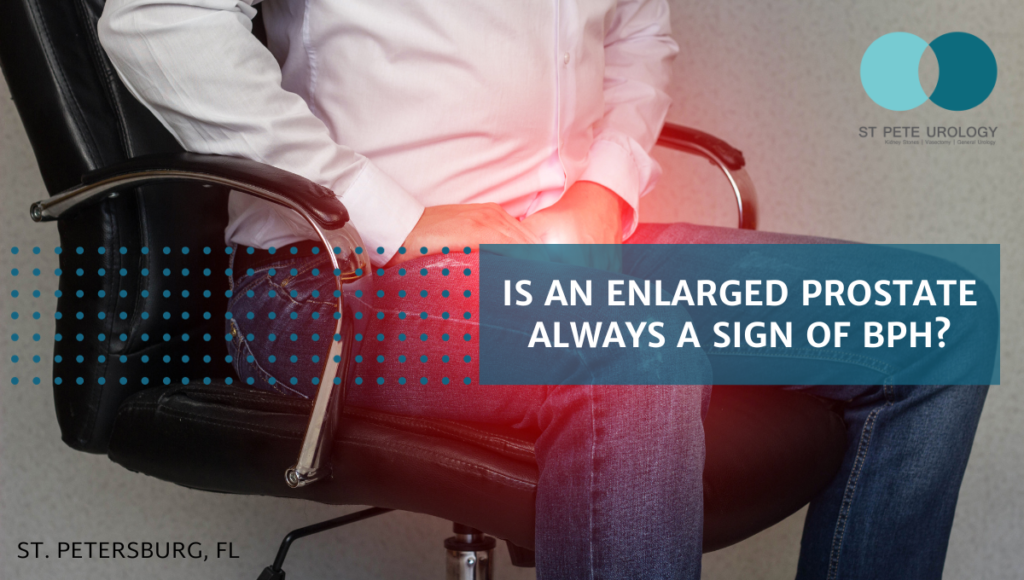
An enlarged prostate is exactly what it sounds like: the gland has grown in size. But why? Several factors, including age and hormone levels, can contribute to this enlargement. But does an enlarged prostate automatically equate to BPH?
Unpacking BPH
BPH is a common condition characterized by an enlarged prostate, but not all instances of prostate enlargement signify its presence. BPH symptoms can involve frequent urination, difficulty starting and stopping urination, and feeling as though your bladder isn’t entirely emptied.
The Other Suspects: Beyond BPH
Prostatitis, inflammation of the prostate, or prostate cancer could also be behind your enlarged prostate. Certain medications, too, can induce prostate enlargement as a side effect. You see, diagnosing BPH isn’t a simple tick-box exercise.
The Art of Distinguishing an Enlarged Prostate from BPH
Your urologist will conduct several diagnostic tests to confirm or rule out BPH. This could include a digital rectal examination, urinalysis, or a prostate-specific antigen test. It’s through understanding these results and your symptoms that BPH can be differentiated from other conditions.
Facing BPH: Your Treatment Options
Should BPH be confirmed, a variety of treatment options are available, from lifestyle changes like reducing fluid intake before bedtime to medication. Minimally invasive procedures are often explored before surgical interventions are considered.
The Uncertainty: When an Enlarged Prostate may not Indicate BPH
If your prostate tests show enlargement, but your symptoms don’t match BPH, your urologist may delve deeper into other potential causes. This could involve further tests and evaluations to rule out serious conditions like prostate cancer.
Conclusion: Key Points and the Path Forward
An enlarged prostate isn’t always indicative of BPH, and true symptom relief depends on identifying the correct underlying issue. Other conditions, medications, and even lifestyle factors can contribute to prostate enlargement. Recognizing this is the first step towards relief.
If you’re facing symptoms that suggest an enlarged prostate, don’t hesitate to seek expert medical advice. In St Petersburg, FL, St Pete Urology offers a dedicated team of experienced urologists determined to diagnose accurately and treat effectively, ensuring your prostate health is in the right hands. So, don’t let worries about your prostate keep you up at night, reach out to St Pete Urology, and take control of your health today.
References:
- St Pete Urology. (2013, March 11). What is Prostate Enlargement? St Pete Urology. https://stpeteurology.com/what-is-prostate-enlargement/
- St Pete Urology. (2018, June 13). Prostate Enlargement BPH. St Pete Urology. https://stpeteurology.com/prostate-enlargement-bph/
- And, D. (2023, September 18). Prostate Enlargement (Benign Prostatic Hyperplasia). National Institute of Diabetes and Digestive and Kidney Diseases; NIDDK – National Institute of Diabetes and Digestive and Kidney Diseases. https://www.niddk.nih.gov/health-information/urologic-diseases/prostate-problems/prostate-enlargement-benign-prostatic-hyperplasia
- NHS Choices. (2023). Overview – Benign prostate enlargement. https://www.nhs.uk/conditions/prostate-enlargement/
- Prostate-Specific Antigen (PSA) Test. (2022, March 11). National Cancer Institute; Cancer.gov. https://www.cancer.gov/types/prostate/psa-fact-sheet
What is Robotic Prostatectomy?
Key Takeaways:
- The da Vinci Robotic Radical Prostatectomy is an innovative surgical technique used to remove the prostate in patients diagnosed with prostate cancer.
- The da Vinci robot provides for less blood loss, smaller incisions, a shorter hospital stay, and quicker recovery than the open approach.
- St Pete Urology in St. Petersburg, FL is leveraging advancements in technology for the benefit of their patients with a commitment to personalized care.
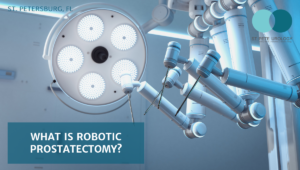 You are living in a time of rapid medical advancement. Nowhere is this progress more evident than in the world of urology, specifically in the treatment of prostate cancer. The once fear-inducing prospect of a radical prostatectomy to combat this disease has been transformed. This transformation has come with the advent of robotic technology. The introduction of the da Vinci robotic radical prostatectomy has revolutionized the way prostate cancer is treated. It has weaved together the threads of technology, human ingenuity, and surgical precision.
You are living in a time of rapid medical advancement. Nowhere is this progress more evident than in the world of urology, specifically in the treatment of prostate cancer. The once fear-inducing prospect of a radical prostatectomy to combat this disease has been transformed. This transformation has come with the advent of robotic technology. The introduction of the da Vinci robotic radical prostatectomy has revolutionized the way prostate cancer is treated. It has weaved together the threads of technology, human ingenuity, and surgical precision.
“Hi, I’m Dr. Nicholas Laryngakis, board certified urologist with St Pete Urology. Some patients are diagnosed with prostate cancer and elect to have surgical removal of their prostate for their best chance of cure,” explains Dr. Laryngakis in an introduction that can put even the most anxious patient at ease.
The Dawn of a New Era in Prostatectomy
Let’s first understand what exactly, at its most fundamental level, robotic prostatectomy is. At the forefront of this innovative surgical technique is the da Vinci Robotic Radical Prostatectomy. This procedure is employed to remove the prostate in patients diagnosed with prostate cancer. Furthermore, the notion of a robot performing surgery may sound like something out of a science fiction novel. However, it is a reality in today’s medical world.
According to Dr. Laryngakis, “The da Vinci robot is the newest technology used to remove the prostate. It provides for less blood loss, smaller incisions, a shorter hospital stay, and quicker recovery. Additionally, this allows patients to return home and resume normal activities sooner than the traditional open approach.” With these benefits, it’s easy to see why this technology has become the preferred method for many urologists in St. Petersburg, FL, and beyond.
Tailoring the Treatment to the Patient
Admittedly, while the da Vinci Robotic Radical Prostatectomy has its advantages, it is not the only solution for prostate cancer treatment. There are traditional open approaches. And, a patient’s individual circumstances will ultimately dictate which method is chosen.
“Both approaches can be done depending on the patient’s situation, but most robotic prostatectomies are the way to treat prostate cancer,” Dr. Laryngakis clarifies. The ability to provide both types of treatment highlights the versatility of modern urology and reinforces the importance of personalized healthcare.
A Beacon of Hope in St. Petersburg, FL
Nestled in St. Petersburg, FL, at the heart of the dynamic Tampa Bay area, you’ll find a urology practice that’s making waves in the fight against prostate cancer. At St. Pete Urology, a team of dedicated professionals, led by board-certified urologists like Dr. Laryngakis. They stand at the forefront of advancing prostate cancer treatment through da Vinci Robotic Radical Prostatectomy.
St. Pete Urology doesn’t just focus on providing top-notch healthcare. Also, they understand that the battle against prostate cancer is both a physical and emotional fight. With a commitment to patient-centric care and a skilled, compassionate team, they offer access to state-of-the-art technologies, including the da Vinci robot. As a result, this makes their practice a beacon of hope for many individuals battling prostate cancer.
In an era where advancements in technology are impacting all areas of life, healthcare stands out as one of the most profoundly touched sectors. As you navigate this landscape, having trustworthy medical professionals on your side is essential. Dr. Laryngakis and his team are demonstrating that when it comes to the fight against prostate cancer. Furthermore, a robotic prostatectomy is a powerful tool in the hands of a skilled urologist. The future of prostate cancer treatment shines brightly in places like St. Petersburg, FL. Here, medical practices like St Pete Urology are leveraging these advancements for the benefit of their patients.
References:
- St Pete Urology. (2011, November 2). Prostate Cancer. St Pete Urology. https://stpeteurology.com/prostate-cancer/
- St. Pete Urology | Urologists in St Petersburg, Florida. (2020, September 14). St Pete Urology. https://stpeteurology.com/da-vinci-laparoscopic-radical-prostatectomy/
- Radical prostatectomy: MedlinePlus Medical Encyclopedia. (2020). Medlineplus.gov. https://medlineplus.gov/ency/article/007300.htm
- Health. (2022). Prostatectomy – for cancer. Vic.gov.au. https://www.betterhealth.vic.gov.au/health/conditionsandtreatments/prostatectomy-for-cancer
- Robotic Surgery for Cancer: The Da Vinci Surgical System. (2022, April). City of Hope. https://www.cancercenter.com/treatment-options/surgery/surgical-oncology/robotic-surgery
How Can You Differentiate Between Kidney and Bladder Stones?
Key Takeaways:
- Kidney and bladder stones are distinct entities with unique causes, symptoms, and treatments.
- Early diagnosis and appropriate treatment are critical in managing both kidney and bladder stones and minimizing their impact on overall health.
- Prevention strategies for kidney and bladder stones include staying hydrated, eating a balanced diet, and treating underlying conditions.
When discussing kidney stones and bladder stones, it’s crucial to note that while they may share similarities in composition and origin, they are distinct entities that manifest uniquely and require separate interventions. Knowing the difference can be key to understanding your symptoms and seeking appropriate treatment.
Causes and Risk Factors
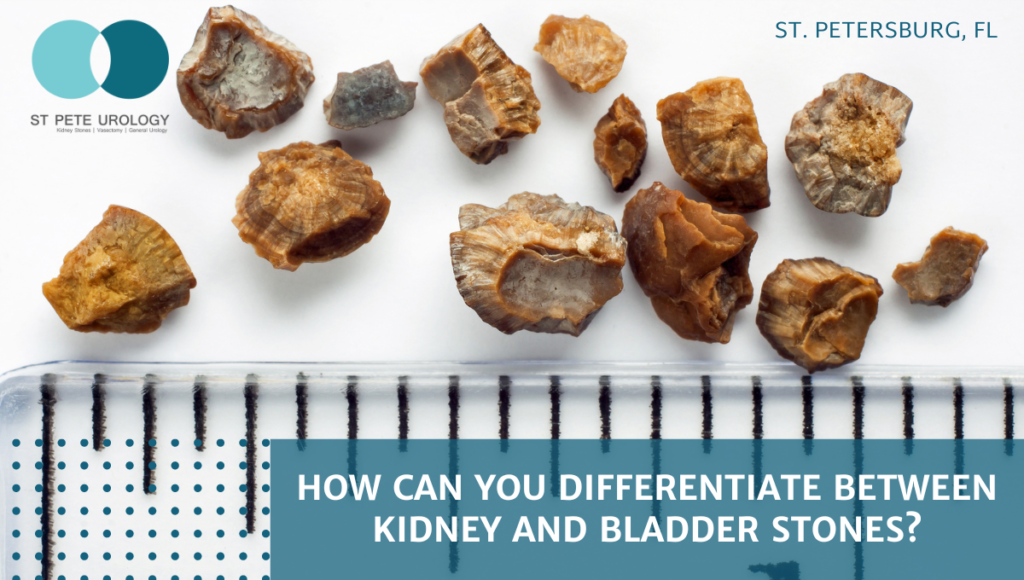
- Kidney stones are frequently the result of accumulating crystals of calcium or uric acid, often rooted in dietary habits, dehydration, or specific medical conditions. The higher concentration of these substances in your urine, the greater the risk of formation.
- Bladder stones, on the other hand, are usually born from recurrent urinary tract infections (UTIs) or from situations that impede urine flow, such as urinary tract blockages or an enlarged prostate. They form when concentrated minerals in the urine crystallize inside the bladder.
Symptoms
Symptoms of kidney and bladder stones can vary greatly, which is why discerning between the two can be so crucial.
- Kidney stones often initially manifest as sharp, severe pain in the back or side below the ribs – a pain so intense, it’s been equated with childbirth. Blood in the urine is a telltale sign, as is an increased frequency and urgency of urination. You may also experience nausea and vomiting.
- Bladder stones differ in that they often cause a noticeable discomfort in the lower abdomen. Like kidney stones, they can increase the frequency of urination, but they may also result in difficulty starting or stopping urine flow, besides the presence of blood in urine.
Diagnostic Tools and Tests
- Diagnosing kidney stones may involve imaging tests such as CT scans, ultrasounds, or X-rays to visualize the stone.
- Bladder stones, conversely, can be diagnosed through a physical examination or similarly with an ultrasound or X-ray. In some cases, a cystoscopy, which uses a thin tube passed through the urethra, is used for diagnosis.
Treatment Options
When kidney stones are small, they may pass on their own – a process expedited by hydration and managed with pain medication. In more severe cases, medications to aid stone passage or dissolve certain stones can be used, or surgical procedures like lithotripsy or nephrolithotomy for larger stones.
Treatment of bladder stones can range from removal during a cystoscopy (for smaller stones) to surgery for larger or complex cases. Addressing underlying causes, such as urinary blockages or UTIs, is often part of the treatment plan.
Prevention Strategies
For kidney stones, staying well-hydrated and eating a balanced diet low in salt and oxalate-rich foods is key. Healthcare professionals may also prescribe particular medications for individuals at high risk.
Prevention of bladder stones often involves appropriate treatment of UTIs, regular emptying of the bladder, and managing underlying conditions, such as an enlarged prostate.
Conclusion
In differentiating kidney stones from bladder stones, it’s clear that despite their similarities, the differences in causes, symptoms, and treatments make them unique health concerns. Early diagnosis and appropriate treatment are critical in managing both and minimizing their impact on your overall health and wellbeing. If you are experiencing symptoms, seeking prompt medical attention is of utmost importance.
For those based in Florida, St Pete Urology is a practice staffed with highly experienced urologists who offer comprehensive care for bladder stones, kidney stones, and other urological conditions. Remember, when it comes to your health, subtleties matter. Swiftly assessing symptoms, seeking professional advice, and beginning an effective treatment plan sooner rather than later could make all the difference. Don’t ignore your body—listen to it and act.
References:
- St. Pete Urology | Urologists in St Petersburg, Florida. (2022, July 11). St Pete Urology. https://stpeteurology.com/kidney-stones/
- St Pete Urology. (2011, November 4). Recurring Urinary Tract Infections. St Pete Urology. https://stpeteurology.com/recurring-urinary-tract-infections/
- St Pete Urology. (2019, July 8). St. Pete Urology | Urologists in St Petersburg, Florida. St Pete Urology. https://stpeteurology.com/why-do-i-keep-getting-utis/
- Kidney Stones. (2021, December 13). National Kidney Foundation; https://www.kidney.org/atoz/content/kidneystones
- NHS Choices. (2023). Overview – Bladder stones. https://www.nhs.uk/conditions/bladder-stones/
- Imaging Tests to Check for Kidney Stones in the Emergency Department | Effective Health Care (EHC) Program. (2016). Ahrq.gov. https://effectivehealthcare.ahrq.gov/products/kidney-stone-imaging/consumer
Technologic Innovations in Urology at St Pete Urology
Key Takeaways:
- St. Pete Urology is at the forefront of integrating advanced technologies like the DAVINCI robot and URONAV MRI ultrasound fusion biopsy technique into their medical practice, offering improved detection and treatment of urological diseases.
- These technological innovations in urology allow for less blood loss and quicker patient recoveries.
- At St. Pete Urology, their commitment to delivering top-quality, technologically advanced care makes them a top choice for anyone seeking urology services in Florida.
If you are seeking innovative solutions for urological issues, look no further than St. Petersburg, FL. As stated by the board-certified urologist Dr. Nicholas Laryngakis, “Urology is a very innovative field.” Based in St. Petersburg, FL, Dr. Laryngakis and his team of skilled urologists at St. Pete Urology have been pioneering advancements in the realm of urology, with technology playing an instrumental role in enhancing patient care, diagnosis, and treatment plans.
Revolutionizing Urology with the DAVINCI Robot
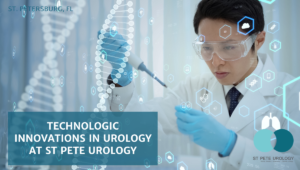 St Pete Urology is at the forefront of integrating advanced technological solutions like the DAVINCI robot into their medical practices. Dr. Laryngakis proudly affirmed, “We were one of the first urology groups to utilize the DAVINCI XI robot on the west coast of Florida.” This cutting-edge tool marks a significant stride in the evolution of urology treatments in St Petersburg, offering a whole new approach to treating prostate and kidney cancer, as well as other urologic diseases.
St Pete Urology is at the forefront of integrating advanced technological solutions like the DAVINCI robot into their medical practices. Dr. Laryngakis proudly affirmed, “We were one of the first urology groups to utilize the DAVINCI XI robot on the west coast of Florida.” This cutting-edge tool marks a significant stride in the evolution of urology treatments in St Petersburg, offering a whole new approach to treating prostate and kidney cancer, as well as other urologic diseases.
The use of the DAVINCI robot underscores the crystallization of innovation and medical excellence at St Pete Urology. It’s not just about the ‘cool factor’ of the technology; it’s about the tangible benefits this technology brings to patients. As Dr. Laryngakis explains, “This provides for less blood loss and quicker patient recoveries.”
Improved Cancer Detection with the URONAV MRI Ultrasound Fusion Biopsy Technique
Another indispensable tool in the technological arsenal of St. Pete Urology is the URONAV MRI ultrasound fusion biopsy technique, which is utilized for prostate cancer detection. Dr. Laryngakis elucidates that this technique steps in “if patients have an elevated PSA or abnormal rectal exam and require a prostate biopsy for diagnosis of cancer.”
The URONAV MRI ultrasound fusion biopsy technique is engineered for precision. It leverages MRI images that are fused with a URONAV-guided biopsy technique. This innovative combination bolsters detection rates, thus promising a more robust and accurate diagnosis for patients.
St Pete Urology: A Vanguard of Innovations in Urology
As you look ahead to your urological healthcare choices, especially if you are based in St. Petersburg, FL consider St Pete Urology. They are not just a team of proficient urologists but pioneers who continually embrace and implement advanced technological innovations in their practices.
In the words of Dr. Laryngakis, “Urology is a very innovative field,” and it is clear that St Pete Urology is actively shaping that field. They employ the DAVINCI robot for surgical procedures. Additionally, they utilize the URONAV MRI ultrasound fusion biopsy technique. These approaches are turning the tide in the detection and treatment of urological diseases.
While the world of urologic treatment can seem intimidating, rest assured that with St Pete Urology, you are not just a patient, but a partner in your healthcare journey. They serve as a beacon of innovation. Their commitment to delivering top-quality, technologically advanced care makes them a top choice for urology services in Florida. Choose St Pete Urology, where technology meets compassion, and innovations in urology pave the way to better health.
References:
- St. Pete Urology | Urologists in St Petersburg, Florida. (2022, July 11). St Pete Urology. https://stpeteurology.com/robotic-surgery/
- St Pete Urology. (2011, November 2). Prostate Cancer. St Pete Urology. https://stpeteurology.com/prostate-cancer/
- Gyles, C. (2019). Robots in medicine. The Canadian Veterinary Journal = La Revue Veterinaire Canadienne, 60(8), 819–820. https://www.ncbi.nlm.nih.gov/pmc/articles/PMC6625162/
- UroNav. (2023). Philips. https://www.philips.com.ph/healthcare/product/HC784026/uronav-mrultrasound-guided-fusion-biopsy-system
- Prostate biopsy. (2021). Prostate Cancer UK. https://prostatecanceruk.org/prostate-information-and-support/prostate-tests/prostate-biopsy

